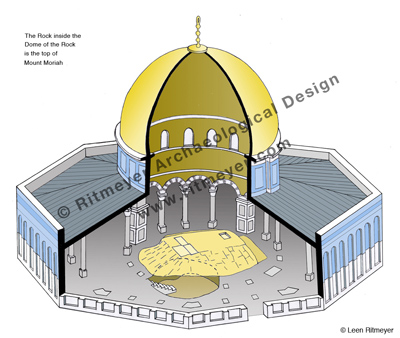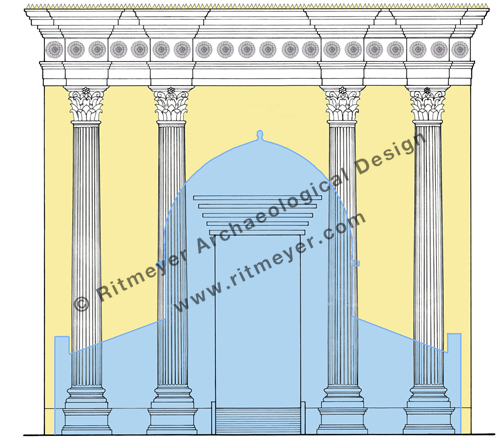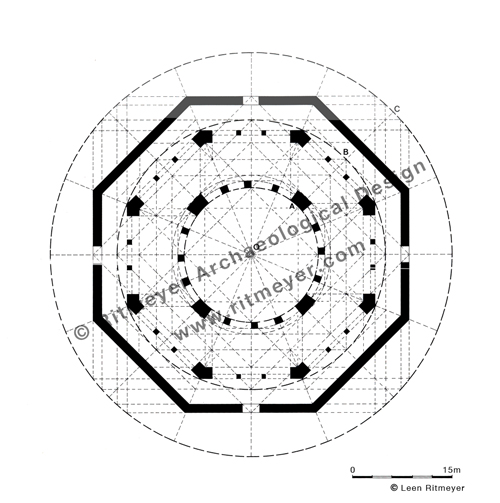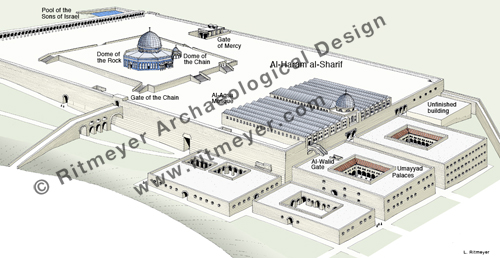Continuing our series on the historical development of Mount Moriah, we have now reached the Early Muslim period. The end of the Byzantine period in Jerusalem was heralded by the Persian invasion of 614 AD and completed by the Muslim conquest twenty-four years later. Muhammad’s successor, Caliph Omar, accepted Jerusalem’s surrender in 638 AD. Muslims regarded Jerusalem as a holy city and Jews were again granted the right to live there and pray on the Temple Mount. Some sources record that Omar ordered the site of the Temple Mount to be cleared of rubbish, thus exposing the Foundation Stone of the Jewish Temple.

Caliph Abd al-Malik (685-705 AD) built a magnificent center for Muslim pilgrimage on the Temple Mount, called the Dome of the Rock.

Completed in 691 AD, the Dome of the Rock was neither a mosque nor a place of prayer, but a shrine to the Foundation Stone of the Temple. Modelled after Byzantine centrally designed commemorative churches, the Muslims transferred to the Temple Mount the story of the Night Journey of Muhammad from Mecca to the “farthest shrine” (al-Aqsa). From here they believed he ascended into Heaven. Now one of the world’s most iconic buildings, known to virtually everyone on the planet, the golden dome that shimmers against the often cobalt blue sky and the blue tiled walls of the octagonal building are both contrasting and harmonious. Few visitors to the site today, however, realise how difficult it is to express its beauty in either geometrical designs or mathematical formulae, especially as we no longer have its original blueprint.
Writing this blog reminded me of the time I worked on the architectural reconstruction of a funeral monument called Gonbad-e-alawiyyan in Persia (Iran) for an Israeli colleague. From this I developed an analysis which is also valid for the plan and section of the Dome of the Rock, the crowning glory of early Islamic architecture. Too complex to describe fully here, it is based on three concentric circles which closely bind together all the different constructional elements into one magnificently proportioned building.

I later applied it successfully to other classical centrally designed buildings, such as the Round Temple at Baalbek, San Vitale at Ravenna, the Mausoleum of Diocletian at Spalato, Hagia Sophia in Istanbul and many others. It is intriguing to think that here we may have a certain school of ancient architecture, which was in use for a long period, but whose traditions were eventually lost.

On completion of the Dome of the Rock, Caliph al-Walid (705-715 AD) built a mosque called al-Aqsa above the Southern Wall of the Temple Mount, on the former site of the Herodian Royal Stoa. The Temple Mount was and still is known to the Muslims as al-Haram al-Sharif (The Noble Sanctuary). The Virtual Walking Tour of al-Haram al-Sharif produced by Saudi Aramco World led by Oleg Grabar, the late Professor Emeritus of Islamic Art and Architecture at the Institute for Advanced Study at Princeton, New Jersey, allows one to explore its jewels of Islamic architecture in a very informative way.
The reconstruction drawing above is the 10th and last in this series that was made specially for our new Temple Mount guide book that is awaiting publication. For the previous drawings see: Mount Moriah, Jebusites, Solomon, Hezekiah, Nehemiah, the Hellenistic and Hasmonean periods , the Herodian period, the Roman period and the Byzantine period.

I am SO enjoying this series-thank you so much for sharing your work.
I am wondering what your opinion is on The Millo of scripture–what and where it was??
Hi Sharon,
Thanks. The Hebrew word Millo comes from a verb that means to fill. We understand it to mean the terrace walls and the filling behind them that had to be built on the steep slopes of the City of David and other places in order to create level areas so that dwellings can be built on them. If it rains much, the fill gets very wet and heavy and that could destroy these terraces and the houses that were built on them. It was therefore the duty of the king to keep these terraces in good order by repairing them when necessary.
Are you sure that Caliph Abd al-Malik (685-705 AD) built the Dome of the Rock ?
It looks just like the octagonal church in Caesarea built 480-500 AD
http://www.digcaesarea.org/images2/1998_Report/98rep26.jpg
or the late fifth century octagonal church in Capernaum
http://www.capernaum.custodia.org/%5Cimg%5Ctabelle%5C385.jpg
http://www.capernaum.custodia.org/default.asp?id=5388
or the mid-5th century octagonal Kathisma Church beside the road to Bethlehem
http://www.tau.ac.il/~rmtrachl/images/identifying_rr_2.jpg
or the late fifth century octagonal church on top of Mount Gerizim
http://c8.alamy.com/comp/BP5JAR/mt-gerizim-the-octagonal-church-built-by-the-byzantine-emperor-zeno-BP5JAR.jpg
Isn’t it more likely that Caliph Abd al-Malik (685-705 AD) took over a already existing octagonal church that maybe had had been burned during the Persian invasion of 614 AD ?
Victor, according to the historical sources, The Rock was on purpose covered with trash in the Byzantine period. The Church of the Holy Sepulchre was built as the new centre of Christian Jerusalem and every trace of Jewish religious identity erased. There is no evidence of a Byzantine church on the Temple Mount at any time. I agree with you that the churches you mention, and there are many others as mentioned in this blog, that have the same architectural plan. The Early Muslim period did not have a architectural tradition, so it seems fair to assume that they used the plan of Byzantine centrally designed memorial churches for the Dome of the Rock. The decoration was done in the eastern tradition of intricate design, but the architecture was Byzantine.